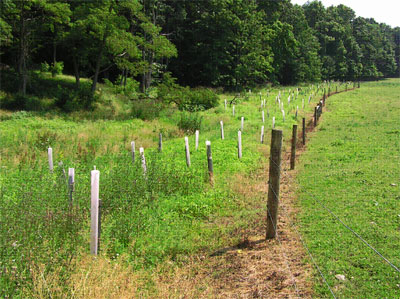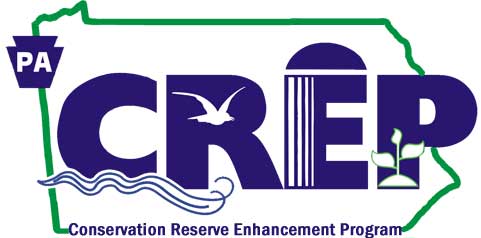Finding the right conservation practice
is the key to CREP's success on your farm.
Consider the following examples...
If you graze livestock near a stream, even a small one, consider native tree and shrub planting, streambank fencing, stream crossings, livestock watering systems. CP 22, CP 29
If you have crop or hayland on a steep hillside and you are tired of battling soil loss and the risk of working the land, consider planting native warm or cool season grasses. Warm season grasses be used in most CREP contract are going to be native, however, not all cool season grasses have to be native. CP 1, CP 2 , CP4D
If you have fields and pastures with low, wet spots or near flood-prone streams, a shallow water area or wetland restoration would be a perfect fit. CP 23, CP 9
If you have an old field, with a non-forested stream running through it, native trees and shrubs can be planted along stream. CP 22 or CP 29
CREP Conservation Practices
|
CP 1 |
Cool Season Grass* |
CP 2 |
Native Grass* |
CP 4D |
Wildlife Habitat* |
CP 8A |
Grassed Waterway |
CP 9 |
Shallow Water Area |
CP 10 |
Established Grass* No longer available |
CP 12 |
Wildlife Food Plots* |
CP 15A |
Contour Grass Strips |
CP 21 |
Filter Strip |
|
Forested Riparian Buffer + |
|
|
CP 25 |
Rare and Declining Habitat |
|
|
CP 30 |
Marginal Pastureland Wetland Buffer |
| CP 33 |
Habitat Buffer or Upland Birds |
|
* Practices for Highly Erodible Land (HEL)
+ Follow link for more detailed information on website |

| Maintaining streambank fencing will keep a farm looking clean and trim even with a "wild," yet healthy looking, riparian streambank buffer. |
More Information:
Common Beneficial Plants
CREP - Wildlife Habitat Fact Sheet
Forested Buffer Flyer CBF

